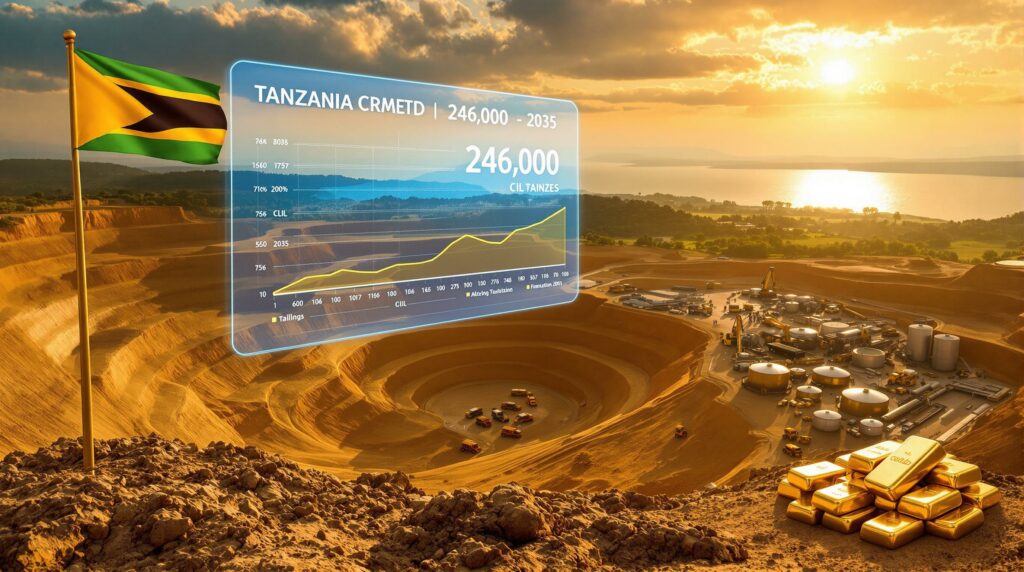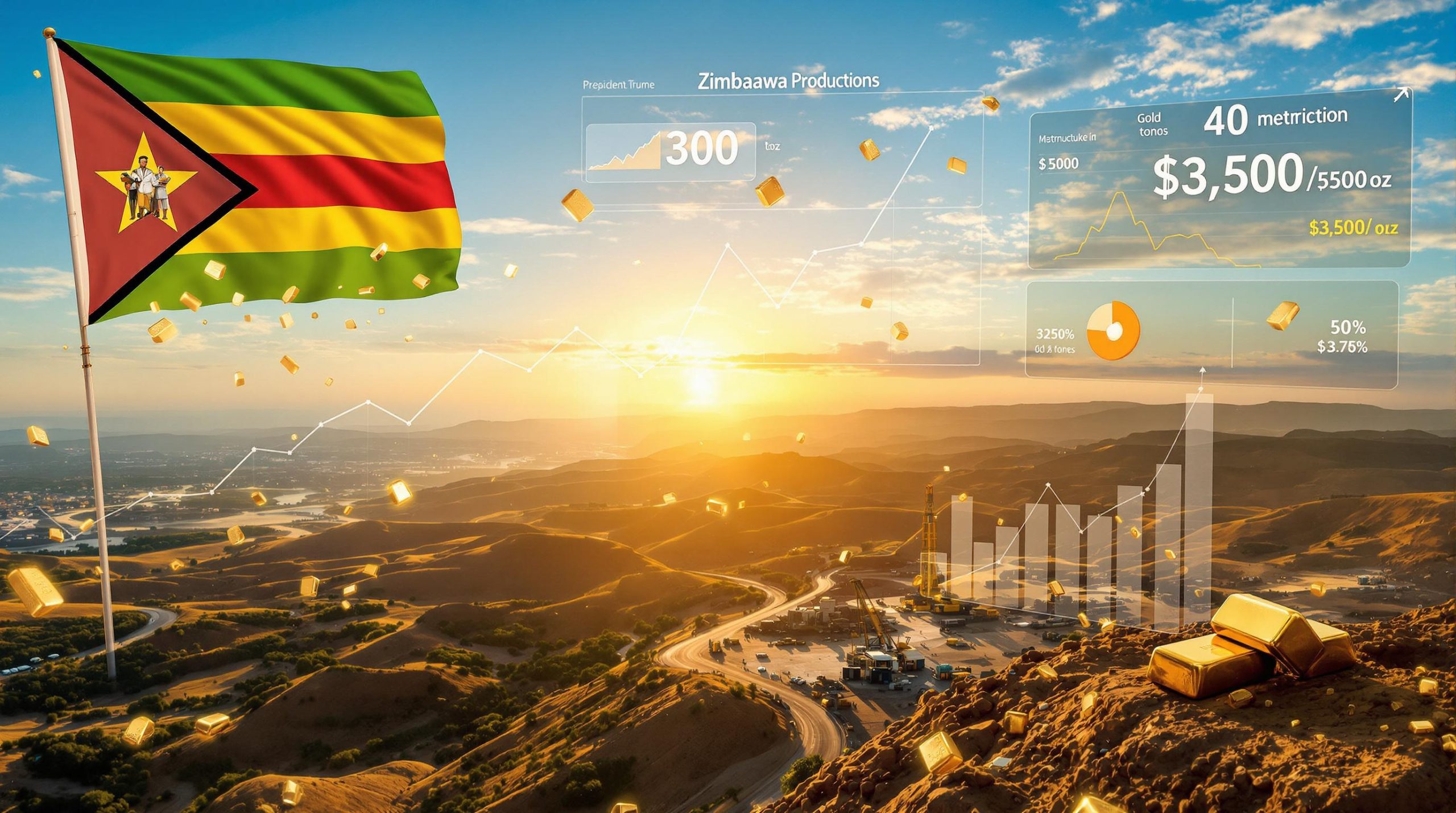Understanding the Nyanzaga Gold Project: Tanzania's Next Major Gold Operation
The Nyanzaga gold project in Tanzania represents one of East Africa's most promising gold mining developments, situated in Tanzania's mineral-rich Lake Victoria Goldfields region. As Perseus Mining advances this substantial project following their April 2025 final investment decision, the development is poised to become a significant contributor to Tanzania's mining sector and economy.
Location and Resource Profile
Located in northwest Tanzania's Lake Victoria Goldfields, the Nyanzaga Gold Project occupies prime position in one of Africa's established gold mining regions. The project encompasses two adjacent deposits – Nyanzaga (also known as Tusker) and Kilimani – containing substantial gold resources.
The current mineral reserve stands at approximately 52 million tonnes of ore with an average grade of 1.40 g/t gold, containing an estimated 2.3 million ounces of gold. This resource base establishes Nyanzaga as one of East Africa's most significant gold development projects, with potential for further resource expansion through continued exploration.
The strategic location provides both geological advantages and logistical benefits, allowing the project to leverage existing regional infrastructure while tapping into Tanzania's proven gold-producing geological formations. Furthermore, recent gold price analysis suggests favorable conditions for new mining operations.
Mining Development and Operations
Perseus Mining has strategically redesigned the Nyanzaga project as a large-scale open-pit mining operation, moving away from the previously considered combination of open-pit and underground mining. This approach optimizes operational efficiency while reducing some of the technical complexities and risks associated with underground mining.
Equipment and Operational Workflow
The mining operation will deploy substantial equipment to achieve its production targets, including:
- Heavy-duty excavators in the 180-350 tonne class
- Large-capacity dump trucks in the 90-150 tonne range
- Front-end loaders for managing stockpiled material
This equipment selection reflects the scale of the operation and the requirement for efficient material movement to support the project's production targets.
The operational workflow follows established large-scale mining practices, with trucks transporting ore to designated surface stockpiles while waste material is directed to purpose-built waste rock dumps. The mining process will utilize conventional drill-and-blast techniques, supplemented by specialized methods including:
- Presplit blasting for precise rock fragmentation
- Trim shots to minimize damage to pit walls
- Controlled blasting practices to optimize ore recovery
- Techniques to reduce waste dilution
These specialized approaches help maintain pit stability while maximizing the recovery of valuable ore and minimizing dilution with waste material. Current gold market performance indicators support the economic viability of such operations.
Processing Infrastructure
At the heart of the operation will be a 5 million tonne per annum conventional carbon-in-leach (CIL) processing plant. This facility represents industry-standard technology that has proven effective for similar gold deposits globally.
The project's supporting infrastructure includes:
| Infrastructure Component | Purpose |
|---|---|
| 11 kV power reticulation | Electricity distribution across the mine site |
| Water supply systems | Sourcing water from Lake Victoria for processing |
| Tailings pipeline | Transport of processed waste material |
| Decant return systems | Water recovery from tailings facility |
| Maintenance workshops | Equipment servicing and repairs |
| Warehousing facilities | Storage of supplies and spare parts |
This comprehensive infrastructure package ensures the operation can function efficiently while managing environmental considerations related to water usage and waste handling.
Economic Fundamentals and Financial Metrics
The Nyanzaga gold project in Tanzania demonstrates robust financial metrics that support Perseus Mining's investment decision, highlighting the project's potential to deliver significant returns.
Production Timeline and Output
The mine's production profile shows:
- First gold production: Targeted for Q1 2027
- Annual gold production: Exceeding 200,000 ounces from 2028 through 2035
- Peak production: Approximately 246,000 ounces expected in the 2028 financial year
- Mine life: At least 8-9 years of full production based on current reserves
This production schedule provides a clear roadmap for the project's operational phase following the ongoing development and construction period. The gold price forecast remains favorable for projects coming online in this timeframe.
Investment Returns and Capital Requirements
Financial analysis of the project reveals compelling economics:
- Pre-tax NPV: $404 million (using a 10% discount rate)
- Internal Rate of Return (IRR): 26%
- Total capital expenditure: $523 million, including:
- $49 million in contingency allowances
- $51 million in pre-production capital
Investment Perspective: The robust 26% IRR places the Nyanzaga project in the upper quartile of gold mining developments globally in terms of expected returns, potentially making it an attractive value driver for Perseus Mining shareholders.
These financial indicators suggest the project offers an attractive return profile, especially when considered against the backdrop of current gold prices and the company's existing operational expertise in African gold mining. Investors may also find interest in undervalued gold stocks within the sector.
Current Implementation Status
Following the April 2025 final investment decision, the Nyanzaga Gold Project has transitioned from planning to implementation phase, with several key development milestones already achieved.
Engineering and Construction Progress
A significant development milestone was recently reached with the awarding of a comprehensive EPCM (Engineering, Procurement and Construction Management) contract to Lycopodium, valued at A$48 million. This appointment represents continuity in project development, as Lycopodium previously contributed to:
- The prefeasibility study
- The definitive feasibility study
- Front-end engineering design phases
This continuity provides valuable institutional knowledge and helps maintain design consistency throughout the development process, potentially reducing execution risks. According to Perseus Mining's development announcement, this partnership is crucial for the project's timely delivery.
EPCM Contract Scope
The EPCM contract encompasses:
- Engineering and design services: Detailed engineering for all project components
- Procurement management: Sourcing equipment and materials
- Construction management: Overseeing on-site building activities
- Commissioning support: Ensuring facilities operate as designed
The comprehensive nature of this contract highlights the project's advancement into the physical construction phase, with activities now focused on bringing the development from design to reality.
Environmental and Social Considerations
Responsible resource development forms a core component of modern mining projects, with the Nyanzaga development incorporating various elements to address environmental and social considerations.
Water Management Approach
The project's design includes water supply infrastructure drawing from Lake Victoria, underlining the importance of responsible water stewardship. While specific water usage volumes have not been disclosed, this aspect of the operation will require:
- Careful monitoring of withdrawal volumes
- Water recycling systems to minimize consumption
- Quality management for any water returned to the environment
- Consideration of seasonal variations in water availability
These considerations are particularly important given the multiple competing uses for Lake Victoria's water resources across the region.
Waste Management Infrastructure
The development includes purpose-built facilities for managing mining waste, including:
- Waste rock dumps: Engineered structures for non-processed waste rock
- Tailings management facilities: For storing processed material
- Tailings pipeline systems: For transporting waste slurry
- Decant return mechanisms: For recovering water from tailings
Environmental Note: Proper design and management of these facilities is critical for preventing acid rock drainage, metal leaching, and other potential environmental impacts associated with mining waste.
Effective implementation of these environmental management systems will be essential for the project's long-term sustainability and regulatory compliance.
Regional Significance and Economic Impact
The Nyanzaga gold project in Tanzania emerges during a period of renewed interest in Tanzania's mining sector, following regulatory reforms and improved government-industry relations.
Tanzania's Evolving Mining Landscape
Tanzania has been working to strike a balance between attracting mining investment and ensuring the country receives appropriate benefits from its natural resources. The development of Nyanzaga signals growing investor confidence in Tanzania's mining framework following a period of regulatory uncertainty.
The project represents a substantial investment in Tanzania's mining industry, with potential to:
- Strengthen the country's position as a significant gold producer
- Demonstrate the viability of large-scale mining under current regulations
- Attract additional investment to the sector
- Contribute to foreign exchange earnings
Local and National Economic Benefits
While specific job creation figures have not been disclosed, projects of this scale typically generate substantial employment and economic multiplier effects:
- Direct employment: Mining operations, processing, and administrative roles
- Indirect employment: Supply chain, services, and supporting businesses
- Skills development: Technical training and capacity building
- Local procurement: Opportunities for regional businesses
- Tax revenue: Corporate taxes, royalties, and personal income taxes
- Infrastructure development: Roads, power, and water systems that may benefit communities
The economic impact extends beyond direct mining activities, potentially catalyzing broader regional development in northwest Tanzania. Current gold market trends suggest continued strong demand for the commodity.
Future Prospects and Operational Considerations
With production targeted to commence in early 2027 and continue through at least 2035, the Nyanzaga project faces both opportunities and challenges that will influence its long-term success.
Growth and Extension Potential
The substantial resource base provides a foundation for the defined mine life, with several avenues for potential extension:
- Resource expansion: Through continued exploration of the existing deposits
- Operational optimization: Improving recovery rates or throughput
- Gold price leverage: Higher gold prices potentially making lower-grade material economic
- Regional exploration: Identifying satellite deposits within the project area
These factors could potentially extend the mine life beyond the currently projected timeframe or enhance the project's economic returns.
Critical Success Factors
Several key variables will influence the project's performance over its operational life:
- Gold price movements: Direct impact on revenue and profitability
- Operational efficiency: Cost control and throughput optimization
- Environmental management: Maintaining compliance and social license
- Government relations: Navigating Tanzania's evolving regulatory landscape
- Community engagement: Building and maintaining positive local relationships
Market Perspective: Gold price sensitivity analysis suggests that for every $100/oz increase in gold price above the base case, the project's NPV could increase by approximately $70-90 million, highlighting the significant leverage to gold price movements.
Effective management of these factors will be crucial for maximizing the project's value and ensuring its sustainability throughout its operational life.
Frequently Asked Questions
When will the Nyanzaga Gold Project begin production?
First gold production is scheduled for the first quarter of 2027, following approximately two years of construction and development after the April 2025 final investment decision.
How much gold will the project produce?
The Nyanzaga project is expected to produce more than 200,000 ounces of gold annually from 2028 through 2035, with peak production of approximately 246,000 ounces projected for the 2028 financial year.
What is the estimated mine life?
Based on current reserves and the planned production rate, the project has a defined operational life extending to at least 2035, representing approximately 8-9 years of full production following commissioning.
Who is developing the Nyanzaga Gold Project?
The project is owned and being developed by Perseus Mining, an established Africa-focused gold producer with existing operations in West Africa. The Nyanzaga project represents Perseus Mining's geographic expansion into East Africa.
What is the environmental management approach?
The project includes dedicated infrastructure for water supply from Lake Victoria, waste rock management facilities, and tailings handling systems, indicating a structured approach to environmental stewardship, though detailed environmental management plans have not been publicly disclosed.
Want to Catch the Next Major Gold Discovery?
Stay ahead of the market with Discovery Alert's proprietary Discovery IQ model, providing instant notifications on significant ASX mineral discoveries like those that could rival Nyanzaga's potential. Explore historic discovery returns and their market impact by visiting our dedicated discoveries page today.




